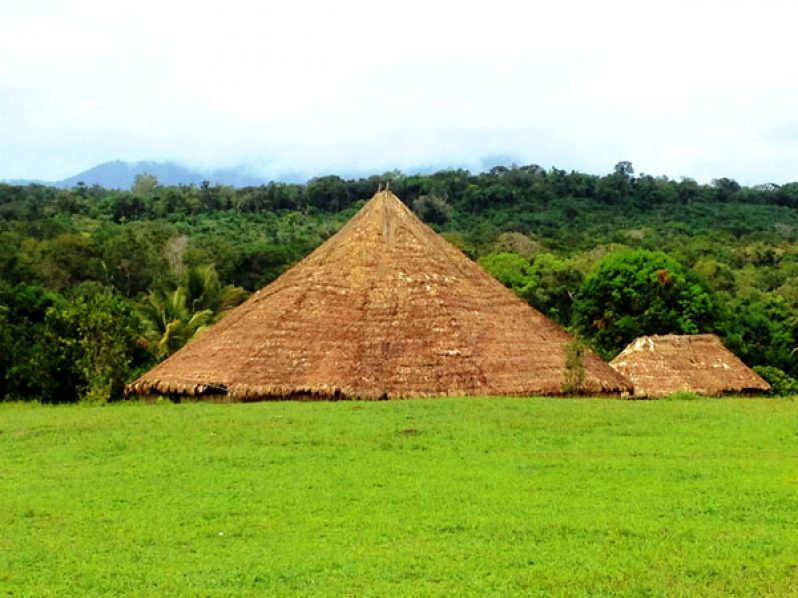GUYANA’S role as a leading pioneer in sustainable forest initiatives worldwide is to be further enhanced on completion of an ongoing collaboration between the World Wildlife Fund (WWF) Guianas and residents of the Deep South Wai Wai Amerindian community of Konashen in Region 9 (Upper Takutu/Upper Essequibo).
Reducing Emissions through Deforestation and Degradation (REDD+) ie: the prevention/ reduction of harmful carbon emissions from deforestation and forest degradation, is the objective of the collaboration.
The establishment of a Community Reporting Monitoring and Verification (CMRV) system for the 1.5 million hectares of rainforest owned by the residents, who live close to the source of the Essequibo River, is the means.
Mr. Charles Hutchinson, Protected Areas/REDD+ Lead in WWF Guyana’s office, has said that the Konashen CMRV project sets out to build the capacity of the Konashen WaiWai community to monitor their own resources, including their forest carbon resources.
“The intention is to empower them to make informed decisions in order to foster their community’s sustained development and the management of their Konashen Community-Owned Conservation Area (KCOCA), as they attempt to have it recognised as a component of Guyana’s Protected Area System (GPAS).”
This project, funded and coordinated by WWF Guianas under a grant from NORAD (the Norwegian Agency for Development Cooperation), also contributes to Guyana’s national forest carbon MRV System by providing the first comprehensive CMRV fully integrated with the national MRVS.
It addresses the broader issues of climate change and biodiversity conservation.
Members of the North Rupununi District Development Board (NRDDB), which benefited from a recent similar CMRV training exercise facilitated by the NORAD-funded Global Canopy Programme (GCP), are delivering the training.
The recent NRDDB project, Hutchinson said, had developed indicators on climatic, biodiversity, ecosystems, cultural services and community health and well-being, with the trainees using smart phones to gather and compile the data for a baseline.
The NRDDB project has also contributed to the North Rupununi communities’ understanding of Payment for Ecosystem Services (PES) and Reduction in Emissions from Deforestation and Degradation (REDD+) activities and potential opportunities.
The Konashen Project is using the techniques and skills developed under this previous GCP/NRDDB/ Iwokrama CMRV Project, which had been implemented across the 16 communities of the North Rupununi, beginning in July 2012 and concluding recently.
The Konashen project aims at developing community capacity to measure and report on key metrics related to REDD+ (forest cover and carbon stock) and metrics which inform their KCOCA management and community development (including biodiversity, fish stocks, wildlife, timber and non-timber products, farmed areas and production, human health, community well-being, and including even a happiness measure!).

It will provide the community with information to underpin its adaptive management processes, and employ climate change adaptation strategies to enable monitoring, as required for management of the KCOCA as a component of the National Protected Area System.
It will help the community to monitor the impacts of any future REDD+ activity that might occur on community lands (if the community chooses to opt-in), with particular regard to social and environmental safeguards; and it would also produce reliable information that can feed into the national MRVS, Hutchinson said.
A community monitor disclosed: “Monitoring will be done every month, collecting information on our natural resource use, our forest, rivers, wetlands and savannah. Also how our village is doing, including our families’ wellbeing and development.”
Monitoring work will be done through field assessment, using a device called smart phone to collect a variety of data, including text, GPS locations, photos, and audio if necessary, by doing interviews with the people, making observations, and looking at village records.
The monitors are expected to produce, in a sustained way, maps showing community resources; submit reports summarising information collected; and present the information to the community at public village meetings.
The Toshao and village council would decide if and when to share data with the Government and other parties.
The project was launched in January of this year with six residents of Konashen being selected by the village leadership as trainees.
The training team consists of trainers from the NRDDB, the GFC, and WWF, and three two-week-long training sessions have already been conducted, all with the exception of the introductory training in Georgetown and Annai, being conducted in Konashen.
The Konashen Project will also help to develop the NRDDB’s capacity to train other indigenous communities in CMRV.
Founder & Executive Director of GCP, Dr. Andrew Mitchell, recently pointed out that Guyana has been a longstanding pioneer in forestry conservation.
The first full scientific expedition to explore the canopy came in 1929 from Oxford University to British Guiana, he said.
WWF Guianas has said that the Deep South Rupununi project is in keeping with its role as the world’s largest conservation organisation with a mission to stop the degradation of the Earth’s natural environment and to build a future in which humans live in harmony with nature.
(By Clifford Stanley)




.png)









